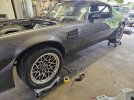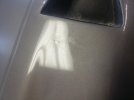i have been helping a friend do his 79 firebird. i only have hood and bumpers left to do. the hood is an aftermarket fiberglass hood. it has a coupe spots of cracks where the "gel coat? seems to be cracked.
can i feather
out with 180 and use 3-4 coats of epoxy to "bury them"
asnd out epoxy and a bit of filler re epoxy?
my plan for the rest of the hood is block with 80 to see how bad it is then a couple coats of epoxy block again to determine if i need to use polyester primer or if epoxy and or 2k will be good enough. i HATE seeing fiberglass parts that are fiberglass wavy. attached is where the car is today, and pictures of the hood
thank you
Marty
can i feather
out with 180 and use 3-4 coats of epoxy to "bury them"
asnd out epoxy and a bit of filler re epoxy?
my plan for the rest of the hood is block with 80 to see how bad it is then a couple coats of epoxy block again to determine if i need to use polyester primer or if epoxy and or 2k will be good enough. i HATE seeing fiberglass parts that are fiberglass wavy. attached is where the car is today, and pictures of the hood
thank you
Marty
Attachments
Last edited:






